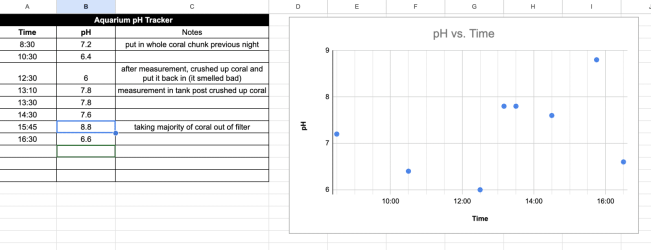fishtime!
Fish Fanatic
So I'm getting a tank ready for a betta fish the cycling looked complete to me, but the pH was 6.0 (or maybe lower because the kit only measure to 6), and I wanted to get the pH up to around 7 at least.
I read that you can used crushed coral and I actually happened to have a piece of coral skeleton on my desk. So I put it in, the pH went up some but came back down, then I crushed it and the pH skyrocketed so I took most of it out. I'm attaching a picture of the pH measurements and when I did things.
Anyways, my point is - am I being nuts trying to find the right portion of coral? Should I be waiting longer before making adjustments to let the carbonate cycle work itself out? Should I bite the bullet and just go buy some crushed coral?
Tank description:
Tank size: 20 gallon tall
Substrate: bottom layer fluval bio stratum, top layer sand
decorations: dragon rock and driftwood
Plants: anubias, amazon frogbit, java moss
Parameters: ammonia - 0 , nitrite - 0, nitrate - .5
Tank inhabitants: a couple pond snails that hitch hiked on the plants
Thanks in advance!

I read that you can used crushed coral and I actually happened to have a piece of coral skeleton on my desk. So I put it in, the pH went up some but came back down, then I crushed it and the pH skyrocketed so I took most of it out. I'm attaching a picture of the pH measurements and when I did things.
Anyways, my point is - am I being nuts trying to find the right portion of coral? Should I be waiting longer before making adjustments to let the carbonate cycle work itself out? Should I bite the bullet and just go buy some crushed coral?
Tank description:
Tank size: 20 gallon tall
Substrate: bottom layer fluval bio stratum, top layer sand
decorations: dragon rock and driftwood
Plants: anubias, amazon frogbit, java moss
Parameters: ammonia - 0 , nitrite - 0, nitrate - .5
Tank inhabitants: a couple pond snails that hitch hiked on the plants
Thanks in advance!


